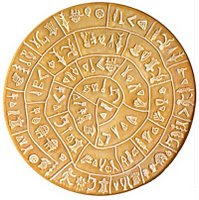Phaistos Shocker!
The Phaistos Disk is not
written in Modern Greek!
Dr. Bruno Fabrizio has returned from Crete with this shocking news. According to Fabrizio’s groundbreaking paper, which was leaked to the press by Nikos the Blade, the most reputable source for news from the underworld of east Iraklio, the well-known Disk of Phaistos is not a cipher of modern Greek. Greece refuses to accept this.
‘This is most certainly not Greek, this disk,’ says Fabrizio. ‘I am tell you what is, this disk, but it is no modern Greek. It is no proto-Byblic either. Very stupid. No Batavian either’.
Authorities have barricaded all access to the Archaeological Museum of Iraklio, the current location of the famous disk, ready to protect the disk and the museum from the ensuing riots.
‘This is the worst riots in the Crete, and in the Greece, since it happens the victory of the Greece in the Euro Cup,’ states Iraklio police chief Nikos Aigofori. ‘There are many peoples, many goats and donkeys in the plataia. It is now hard for me to enjoy my bougatsa. But it is ready for us; we will protect the disk at all costs, until five this evening'.
When asked what he thought the reaction would be among the Greek diaspora, Aigofori replied, ‘Why? You know my cousin? What he says about me? Don’t listen to him'.
Fabrizio was unmoved by the riots all over Greece in protest to his controversial finding, though he did ackowledge the death threats. He asserted that the truth is the truth. He is currently being protected by Swiss authorities in Ticino. In Locarno, actually. He is often found at the Caffè Poggio, between 2 and 4pm.
[Ed.: Below is Fabrizio’s translation. He has rendered the translation of the original Mesaran, as Fabrizio calls it, into English.]
The Disk of Phaistos, translation and explication by Dr. Bruno Fabrizio, currently visiting scholar at Università di Baiae (editorial assistance provided by Fragmentary Poets)
Each of the forty-five imprimati may be read as either a phonetic sign or as a logogram or as a determiner. So they may have sound value, word value, or only semantic value. This depends entirely on context. Mesaran is a complex language.
Side 1: It is impossible to discern which side is the first, so my choice is arbitrary, but it will be clear that it does not matter. The side begins from the center and spirals outward.

The text (in English): 'Not redeemable for cash; property of Mesara Casino and Spa; destruction is punishable with impressment into the Rhadamanthys Legion’s Foreign Brigade; while in Mesara enjoy these services from our partner businesses: Agia Triada Escorts; Matala Massage Parlor; Adult Tablet and Mime of Gortyn'.
Side 2, text: Lotus Line Personals: 'Potniai seeking boys: Lotus-lover seeks athletic, unconventional boy; kernos major in college seeks leather- and yoking-partner in business-minded boy, send your horn or carrier-pigeon; Do you like long walks on the hot, Mesara plain? Tired of jumping bulls? If so, and you are a stylish boy, meet me in the Kamares cave for a good time. [new passage] Do the Mycenaeans get you down? Come east for peace. Caves of Diktē is a closed, resort community now accepting reservations'.

These texts are the missing link that scholars have been seeking. Phaistos was clearly the economic center of the region, with ample storage and accommodation and catering services. Agia Triada now seems to be the detached high-roller suites. Kommos, the seaport for the Mesara, has puzzled with its foreign artifacts. It now clearly seems to be the 'party spot' of the island, the probable destination for Cypriot, Egyptian, Ugaritic and even counter-cultural Mycenaean revelers.
By analogy, the role and function of Knossos, Amnisos, Malia, Gournia, Mokhlos, Palaikastro, and Kato Zakros must now be reconsidered. [Graduate students in classical archaeology are expected to join the riots.]
